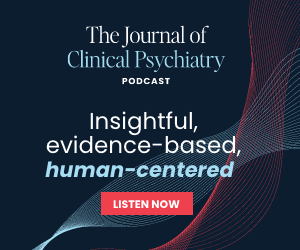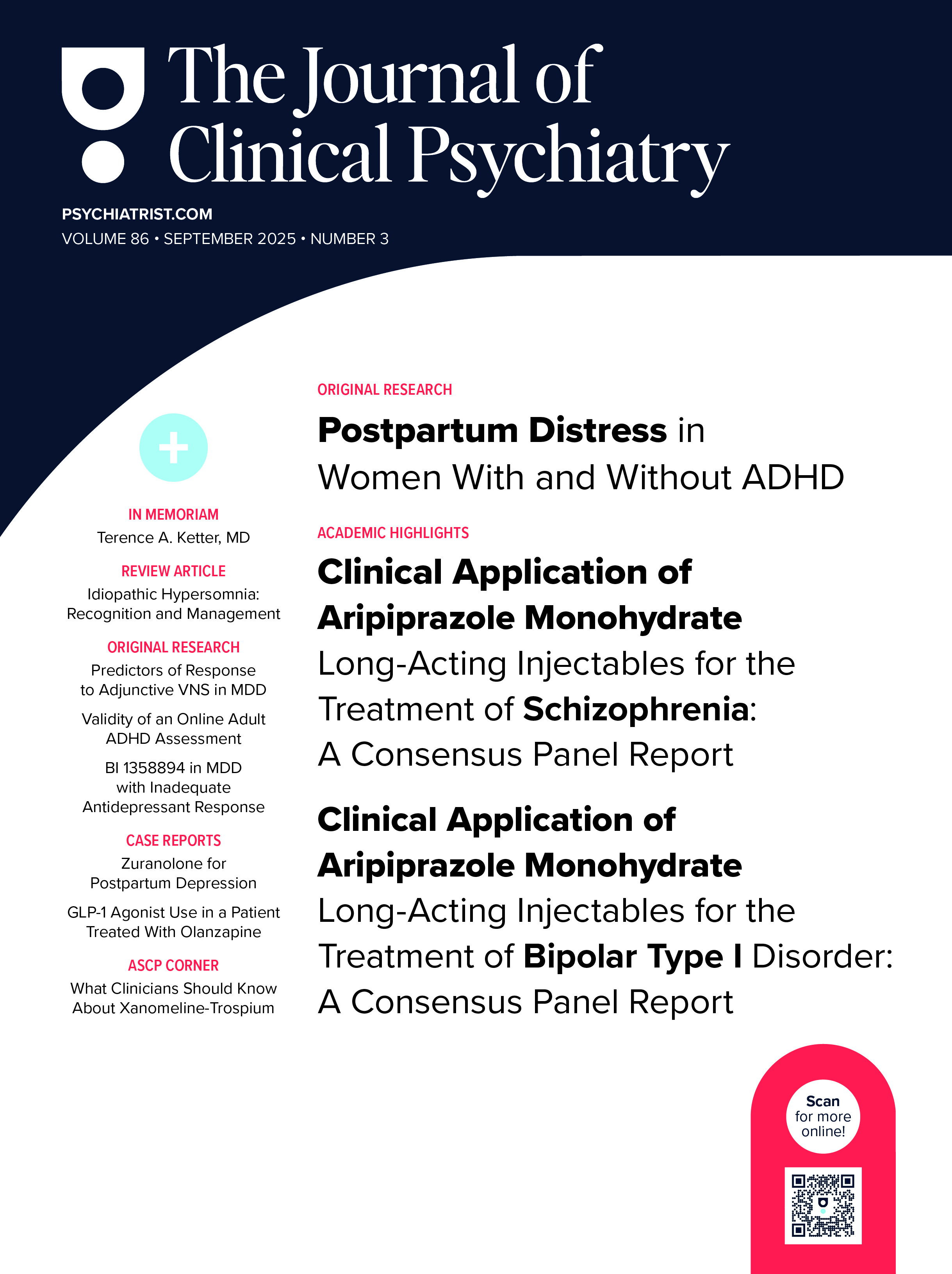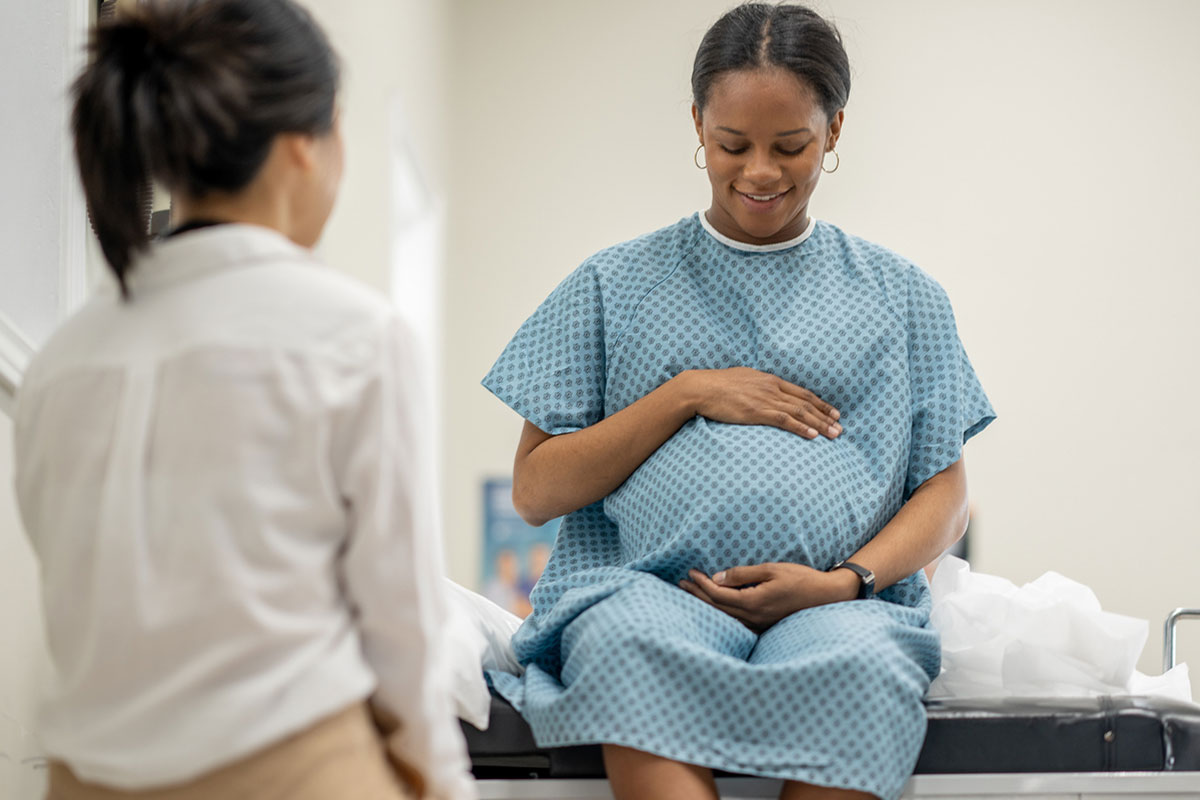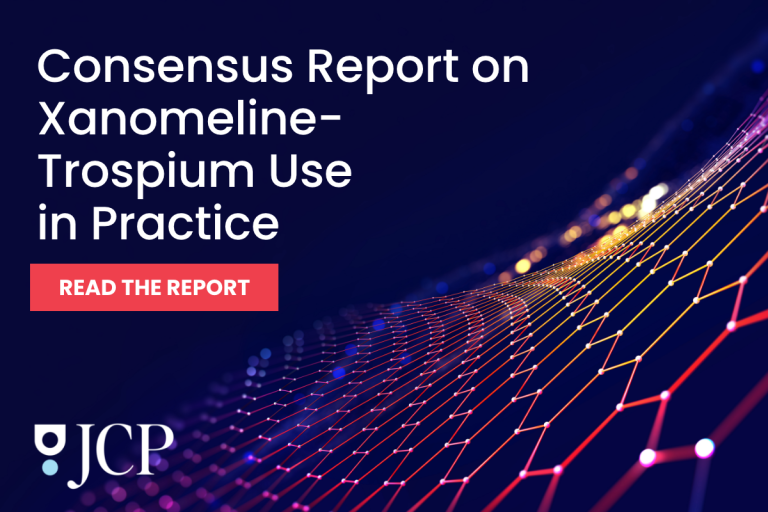The risks of valproate use in pregnancy are extensive and well-established. Its teratogenic effects were first reported in the 1980s, leading to the first boxed warning in 2003.1,2 The nature of the teratogenicity encompasses a spectrum of congenital malformations, including skeletal, cardiovascular, genitourinary malformations, neural tube defects of varying degrees of severity, and facial deformities such as cleft lip/palate, affecting approximately 11% of exposed fetuses.3–5
Additionally, a wide range of neurodevelopmental conditions, including intellectual, cognitive, language, and motor delays; autism spectrum disorder; and attention-deficit/hyperactivity disorder, affect 30–40% of those exposed to valproate in utero.6–9 These outcomes, collectively known as “fetal valproate syndrome” or “fetal valproate spectrum disorder,” are associated with significant disability and are at times incompatible with life, making valproate the most serious teratogen in psychopharmacology.10–12
In the United States, approximately 45% of pregnancies are unplanned,13 and people with mental illness demonstrate a greater likelihood of unintended pregnancies than the general population.14–16 Unintended pregnancies will typically be recognized beyond the timeframe of neural-structural development, a time of vulnerability to teratogenicity from in utero exposure to valproate.17 Furthermore, once a pregnancy is recognized, a woman taking valproate faces the difficult decision of whether to terminate the pregnancy—and if continuing the pregnancy, whether to discontinue valproate treatment and risk relapse of mental illness.
Warnings of the risks of valproate in pregnancy have been issued by domestic and international regulatory agencies for over a decade.18–20 The most recent US Food and Drug Administration (FDA) boxed warning for valproate states, “Valproate should not be administered to a woman of childbearing potential unless other medications have failed to provide adequate symptom control or are otherwise unacceptable” and that women “should use effective contraception while using valproate” and “should be counseled regularly regarding the relative risks and benefits of valproate use during pregnancy.”21 Going further, a recent call was made for providers considering prescribing valproate to women of reproductive potential to simply “forget it exists.”22
Despite the FDA warning and clear guidance for prescribers, the rate of valproate prescriptions in the US for nonepileptic patients of reproductive age has not declined,23 nor has the rate of valproate-exposed pregnancies in the last 15 years.24 When broken down by indication for valproate use in pregnancy, psychiatry predominates, with 52% of prescriptions for mood disorders, 18% for migraines, and 12% for epilepsy.24 While high-dose folic acid supplementation prior to conception and during pregnancy is routinely recommended for those taking valproate, data have failed to confirm its ability to mitigate the risks.25
Several European regulatory agencies have implemented risk minimization measures, which have resulted in reduced valproate exposures in pregnancy.26–29 Some of these strategies include mandated enrollment in a pregnancy prevention program that encompasses documentation of effective contraception and monthly pregnancy tests, a visual warning displayed on medication packaging, and mandatory annual completion of a form justifying continued use of valproate rather than alternative agents.12,26,30,31 The US FDA has enacted Risk Evaluation and Mitigation Strategies (REMS) for medications with teratogenic risks similar to valproate.32 For example, the iPLEDGE REMS system for isotretinoin, an acne medication with high potential for teratogenicity, requires that patients using the medication (1) attest to either abstinence or use of two simultaneous and continuous forms of contraception, (2) provide written acknowledgment of the teratogenic risks, and (3) undergo pregnancy testing prior to treatment and monthly during treatment.33
Clearly, safeguards should be in place in the US. We propose creating a REMS for monitoring of valproate prescription to women of reproductive age. This valproate REMS could include the following measures:
- Signed patient consent indicating the reason for valproate use and acknowledgment of teratogenic risk.
- Patient receipt of contraceptive education and a pregnancy prevention guide (similar to iPLEDGE for isotretinoin).
- Confirmation of a reliable contraception method or confirmation of changes incompatible with pregnancy (eg, hysterectomy or menopausal state).
- For patients capable of pregnancy, reliable documentation of nonpregnancy prior to valproate initiation and at every psychiatric outpatient visit during the course of valproate treatment.
Furthermore, we recommend addition of visual warnings of teratogenicity to valproate packaging.
In conclusion, while valproate remains an invaluable medication for certain severe psychiatric and neurologic health conditions,34 the high risk of teratogenicity necessitates stringent safeguards to regulate its use by individuals capable of pregnancy. Current data indicate an alarming persistence of valproate-exposed pregnancies despite existing warnings. A structured REMS program incorporating mandatory patient consent, robust contraceptive education, periodic verification of pregnancy status, and clear labeling could significantly mitigate these risks. By aligning efforts with successful European strategies and similar FDA regulations for other teratogenic drugs, we can ensure that the therapeutic benefits of valproate are harnessed while safeguarding against preventable fetal harm. Implementing these measures is imperative to uphold patient safety and public health.
Article Information
Published Online: October 6, 2025. https://doi.org/10.4088/JCP.25com16026
© 2025 Physicians Postgraduate Press, Inc.
J Clin Psychiatry 2025;86(4):25com16026
Submitted: July 2, 2025; accepted July 29, 2025.
To Cite: Suleiman M, Silver DF, Forray A, et al. Beyond the boxed warning: a call for regulation of psychiatry’s most teratogenic drug. J Clin Psychiatry 2025;86(4):25com16026.
Author Affiliations: Icahn School of Medicine at Mount Sinai, New York, New York (Suleiman); Women’s Behavioral Health, Departments of Obstetrics/Gynecology and Psychiatry, UPMC in Central Pennsylvania, Camp Hill, PA (Silver); Department of Psychiatry, Yale School of Medicine, New Haven, Connecticut (Forray); Center for the Study of Healthcare Innovation, Implementation & Policy, VA Greater Los Angeles Healthcare System, Los Angeles, California (Goodsmith); VA Desert Pacific Mental Illness Research, Education, and Clinical Center, Los Angeles, California (Goodsmith); David Geffen School of Medicine, University of California Los Angeles, Los Angeles, California (Goodsmith).
Corresponding Author: Mariella Suleiman, MD, Icahn School of Medicine at Mount Sinai, 1 Gustave L. Levy Pl, New York, NY 10029 ([email protected]).
Relevant Financial Relationships: The authors have no financial disclosures or conflicts of interest to declare.
Funding/Support: No funds, grants, or other financial support was received for this project.
Disclaimer: The views expressed are those of the authors and do not necessarily reflect the position or policy of the Department of Veterans Affairs or the United States government.
ORCID: Mariella Suleiman: https://orcid.org/0000-0001-8414-8843; David F. Silver: https://orcid.org/0000-0001-5501-9938; Ariadna Forray: https://orcid.org/0000-0002-5806-8767; Nichole Goodsmith: https://orcid.org/0000-0001-8440-5934
References (34)

- Robert E, Guibaud P. Maternal valproic acid and congenital neural tube defects. Lancet. 1982;2(8304):937. PubMed CrossRef
- Wartman C, VandenBerg A. Valproate: not all boxed warnings are created equal. Ann Pharmacother. 2022;56(12):1349–1355. PubMed CrossRef
- Weston J, Bromley R, Jackson CF, et al. Monotherapy treatment of Epilepsy in pregnancy: congenital malformation outcomes in the child. Cochrane Database Syst Rev. 2016;11(11):CD010224. PubMed CrossRef
- Campbell E, Kennedy F, Russell A, et al. Malformation risks of antiepileptic drug monotherapies in pregnancy: updated results from the UK and Ireland Epilepsy and Pregnancy Registers. J Neurol Neurosurg Psychiatry. 2014;85(9):1029–1034. PubMed CrossRef
- Tanoshima M, Kobayashi T, Tanoshima R, et al. Risks of congenital malformations in offspring exposed to valproic acid in utero: a systematic review and cumulative meta-analysis. Clin Pharmacol Ther. 2015;98(4):417–441. PubMed CrossRef
- Bromley R, Adab N, Bluett-Duncan M, et al. Monotherapy treatment of epilepsy in pregnancy: congenital malformation outcomes in the child. Cochrane Database Syst Rev. 2023;8(8):CD010224. PubMed CrossRef
- Christensen J, Grønborg TK, Sørensen MJ, et al. Prenatal valproate exposure and risk of autism spectrum disorders and childhood autism. JAMA. 2013;309(16):1696–1703. PubMed CrossRef
- Meador KJ, Baker GA, Browning N, et al. Fetal antiepileptic drug exposure and cognitive outcomes at age 6 years (NEAD study): a prospective observational study. Lancet Neurol. 2013;12(3):244–252. PubMed CrossRef
- Veroniki AA, Rios P, Cogo E, et al. Comparative safety of antiepileptic drugs for neurological development in children exposed during pregnancy and breast feeding: a systematic review and network meta-analysis. BMJ Open. 2017;7(7):e017248. PubMed CrossRef
- Clayton-Smith J, Bromley R, Dean J, et al. Diagnosis and management of individuals with fetal valproate spectrum disorder; a consensus statement from the European Reference Network for Congenital Malformations and Intellectual Disability. Orphanet J Rare Dis. 2019;14(1):180. PubMed CrossRef
- Daugaard CA, Pedersen L, Sun Y, et al. Association of prenatal exposure to valproate and other antiepileptic drugs with intellectual disability and delayed childhood milestones. JAMA Netw Open. 2020;3(11):e2025570. PubMed CrossRef
- Andrade C. Valproate in pregnancy: recent research and regulatory responses. J Clin Psychiatry. 2018;79(3).
- Finer LB, Zolna MR. Declines in unintended pregnancy in the United States, 2008-2011. N Engl J Med. 2016;374(9):843–852. PubMed CrossRef
- Adan Sanchez AY, McMillan E, Bhaduri A, et al. High-risk sexual behaviour in young people with mental health disorders. Early Interv Psychiatry. 2019;13(4):867–873. PubMed CrossRef
- Tozoglu OEAN, Yalcin US, Kasali K. Unintended and unwanted pregnancies in women with major psychiatric disorders: a cross-sectional comparative study. Psychiatry Clin Psychopharmacol. 2020;30(3):230–240.
- Schonewille NN, Rijkers N, Berenschot A, et al. Psychiatric vulnerability and the risk for unintended pregnancies, a systematic review and meta-analysis. BMC Pregnancy Childbirth. 2022;22(1):153. PubMed CrossRef
- Branum AM, Ahrens KA. Trends in timing of pregnancy awareness among US women. Maternal Child Health J. 2017;21(4):715–726. PubMed CrossRef
- US Food and Drug Administration. FDA Drug Safety Communication: Children born to mothers who took Valproate products while pregnant may have impaired cognitive development. 2018. https://www.fda.gov/drugs/drug-safety-and-availability/fda-drug-safety-communication-children-born-mothers-who-took-valproate-products-while-pregnant-may#:∼:text=If%20you%20take%20valproate%20during,anti%2Dseizure%20medicine%20during%20pregnancy
- US Food and Drug Administration. FDA Drug Safety Communication: Valproate Anti-seizure Products Contraindicated for Migraine Prevention in Pregnant Women due to Decreased IQ Scores in Exposed Children. 2016. Accessed November 2, 2024. https://www.fda.gov/drugs/drug-safety-and-availability/fda-drug-safety-communication-valproate-anti-seizure-products-contraindicated-migraine-prevention#tabs-1
- World Health Organization. Statement on the Risks Associated With Valproic Acid (Sodium Valproate) In Women And Girls Of Childbearing Potential. WHO. Accessed June 19, 2024. www.who.int/news/item/02-05- 2023-use-of-valproic-acid-in-women-and-girls-of- childbearing-potential
- Depakote (Divalproex Sodium). Package insert. AbbVie, Inc; 2024. Accessed January 26, 2025. https://www.accessdata.fda.gov/drugsatfda_docs/ label/2024/018723s068lbl.pdf
- Freeman MP. Prescribing guideline for valproic acid and women of reproductive potential: forget it exists. J Clin Psychiatry. 2022;83(6).
- Adedinsewo DA, Thurman DJ, Luo YH, et al. Valproate prescriptions for nonepilepsy disorders in reproductive-age women. Birth Defects Res A Clin Mol Teratol. 2013;97(6):403–408. PubMed CrossRef
- Smolinski NE, Sarayani A, Thai TN, et al. Prenatal exposure to valproic acid across various indications for use. JAMA Netw Open. 2024;7(5):e2412680. PubMed CrossRef
- Vajda FJE, O’Brien TJ, Graham JE, et al. Folic acid dose, valproate, and fetal malformations. Epilepsy Behav. 2021;114(Pt A):107569. PubMed
- Degremont A, Kerbrat S, Balusson F, et al. Prescribing trends for valproate among pregnant women: a cross-sectional study in 2013 and 2016 using the French Health Insurance Database. Neurology. 2022;98(21):e2163–e2173. PubMed CrossRef
- Gaudio M, Konstantara E, Joy M, et al. Valproate prescription to women of childbearing age in English primary care: repeated cross-sectional analyses and retrospective cohort study. BMC Pregnancy Childbirth. 2022;22(1):73. PubMed CrossRef
- Wojcik K, Kruk M, Kon B, et al. Treatment patterns in women of childbearing age and pregnant women with epilepsy in Poland between the years 2019 and 2022-A nationwide population-based cohort study. Seizure. 2024;115:75–80. PubMed
- Scholz K, Koster I, Meyer I, et al. Prescribing of valproate and oral antiepileptics for women of childbearing age and during pregnancy in Germany between 2010 and 2020. Pharmacoepidemiol Drug Saf. 2023;32(11):1306–1314. PubMed CrossRef
- Fauvelle K, Bigna JJ. Compliance with prescribing and dispensing conditions for valproate and related substances in girls and women of childbearing potential: a Survey of community pharmacists in France. Drug Saf. 2023;46(2):121–128. PubMed CrossRef
- European Medicines Agency. New Measures to Avoid Valproate Exposure in Pregnancy Endorsed. European Medicines Agency; 2018. https://www. ema.europa.eu/en/medicines/human/referrals/ valproate-related-substances-0
- Draghici CC, Miulescu RG, Petca RC, et al. Teratogenic effect of isotretinoin in both fertile females and males (Review). Exp Ther Med. 2021;21(5):534. PubMed CrossRef
- iPledge. iPledge REMS. 2021. Accessed June 26, 2024. www.ipledgeprogram.com
- Goldberg JF. Living in a pharmacologically imperfect world. J Clin Psychiatry. 2022;83(6). 22ed14665. PubMed CrossRef
This PDF is free for all visitors!





